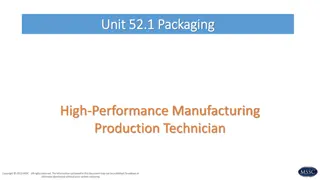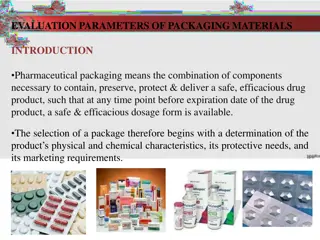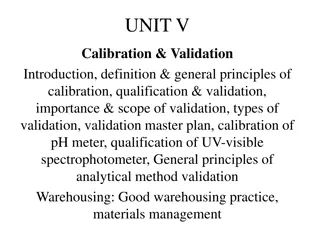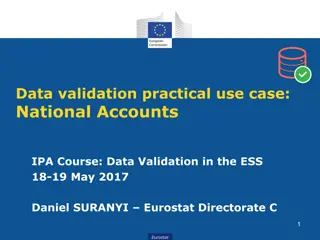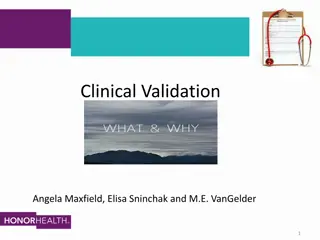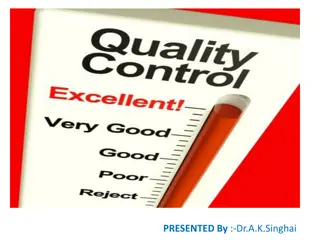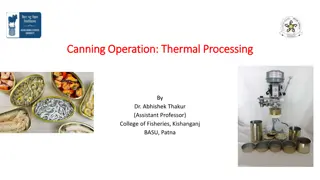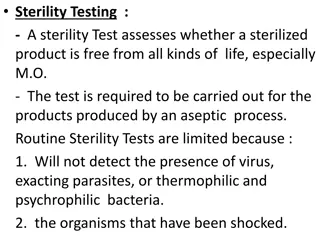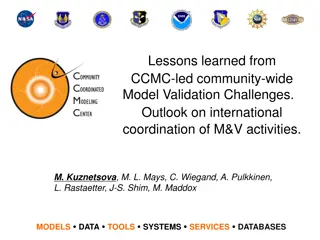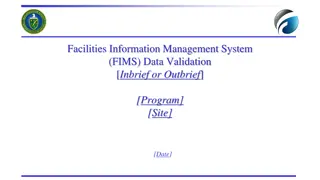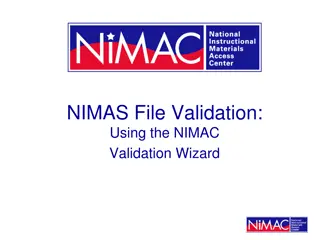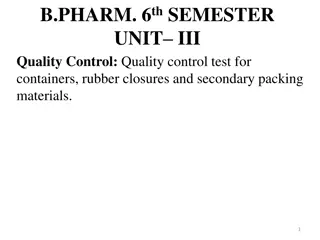Validation and Sterility Assurance in Packaging Systems: Key Considerations
This content discusses the requirements for validating packaging systems and ensuring sterility, presented by Hartmut Dunkelberg from the University Medical Center in Goettingen, Germany. Key topics covered include the validation of basic operations such as emptying catheter bags, risks of contamination, validation of visual inspection methods, and responsibilities in handling terminally sterilized products. The importance of maintaining sterility and preventing cross-contamination is emphasized throughout the document.
Download Presentation

Please find below an Image/Link to download the presentation.
The content on the website is provided AS IS for your information and personal use only. It may not be sold, licensed, or shared on other websites without obtaining consent from the author. Download presentation by click this link. If you encounter any issues during the download, it is possible that the publisher has removed the file from their server.
E N D
Presentation Transcript
Requirements of validation of packaging systems and sterility assurance Hartmut Dunkelberg University Medical Center, Goettingen, Germany 16th World Sterilization Congress & Annual conference of AFS 7-10 October 2015, Lille, France
Topics 1. Emptying catheter bags: an example of validation of basic operations 2. Risk of infection when using sterilized products contaminated with a low count of environmental microbes 3. Validation of visual inspection of sterile barrier systems as one of the methods to detect compromised sterility; relevance of punctures, wet bursting strength, bursting strength and tearing resistance 4. Validation of maintenance of sterility: compatibility of airborne microbial filtration efficiency of sterile barrier systems with airborne microbial challenge 5. Responsibility for the handling of terminally sterilized products
Emptying catheter bags an example for validation of basic operations
Risks of cross contamination when emptying catheter bags Contamination of the doorhandles Contamination of the washer-disinfector handle Contamination of the clean container found in the washer-disinfector Contamination of the on/off button
Validation of the procedure for emptying catheter bags Predetermined acceptance criterion: strict hygienic isolation of work steps with pathogen contact from those without
Proposal for a written documentation of work steps emptying catheter bags Step 1: assemble the required equipment; Step 2: hand hygiene, put on disposable gloves, ; Step 3: steps including the risk of contaminating the gloves: clean drainage bag outlet with alcohol-based wipe, place urinary container under drainage bag outlet, etc.
Documentation of work steps emptying catheter bags II Step 4: hygienic isolation of following operations, o Alcohol-based hand rub of both hands with gloves o Hand 1 (with risk of contamination) is used for transporting and emptying the container o Hand 2 is used for the following clean operations: opening the doors, opening and closing the door of the washer-disinfector, pressing the button Step 5: remove and discard gloves, hand hygiene with alcohol- based hand rub
Risk of infection when using sterilized products contaminated with a low count of environmental microbes
Infection/outbreak Aspergillus meningitis outbreak in 2 hospitals in Sri Lanka after spinal anaesthesia for caesarean section 1 Outbreak with 80 cases of BSI in 6 US states after use of heparinized saline flush syringes 2 Cause sub-optimal storage of sterile devices for over 6 months after tsunami was most plausible reason Remarks No infections when syringes are used for other injections. Unopened syringes showed growth. Syringes were prepared as compounded medical products. P. fluorescens was identified in unopened syringes; The specific source of contamination could not be identified. Exposure to propofol in 7 hospitals was associated with postoperative infections3 Risks: use syringes of propofol that had been prepared up to 24 h beforehand , prepare multiple syringes at one time for use throughout the day. 1) Guaratne et al.: Ceylon Medical Journal 2006;51:137-42; 2) Gershman et al.: Clinical Infectious Diseases 2008;47:1372-9 3) Bennet et al.: N Engl J Med 1995;333:147-54
Recommendations to reduce the risk of microbial growth by shortening the in-use application time From a microbiological point of view, the product should be used immediately1 Replace tubing used to administer blood, blood products, or fat emulsions ( ) within 24 hours of initiating the infusion2 Propofol: use strict aseptic technique discard within 12 hours of opening3 1) CPMP (Commitee for proprietary medicinal products), 1998 2) CDC, 2011: Guidelines for the prevention of intravascular catheter-related infections, 2011 3) Labeling text of the manufacturer
Validation of visual inspection as one of methods to detect compromised sterility; relevance of puntcures, wet bursting strength, bursting strength and tearing resistance
Defect detection rates of visual inspection of compromised packagings* Defect size (mm) Defect detection rate of visual inspection 1.1 6.7 % 3.7 64.4 % *Data from Waked et al.: Sterilization wrap inspections do not adequately evaluate instrument sterility. Clin Orthop Relat Res 2007;462:207-11
Mechanical pressure caused bursting during steam sterilization:
Limit values of bursting strength, wet bursting strength, and internal tearing resistance according to EN 868 part 2-10 Performance parameter Material Unit Paper (for pouches, reels) Coated nonwoven m. of polyolefins (for pouches, lids) Uncoated nonwoven m. of polyolefines (for pouches, lids) Bursting strength Wet bursting strength kPa kPa 230 35 700 - 575 - Internal tearing resistance mN 550 700 1000
Sporadic device-associated infections caused by compromised packaging integrity are difficult to identify because the microbiological status of the unopened device can no longer be examined, because exposures and patients are scattered or isolated in time and location.
Validation of maintenance of sterility: compatibility of airborne microbial filtration efficiency of sterile barrier systems with airborne microbial challenge
ISO 11607-1 Porous materials shall provide an adequate microbial barrier to microorganisms in order to provide integrity of the sterile barrier system and product safety. *) *ISO 11607-1, 2006, clause 5.2.2
ISO 11607-1 the conditions under which the preformed sterile barrier system are handled shall be established, controlled and recorded to ensure that the conditions are compatible with the use for which the material and/or sterile barrier system is designed . : *) Temperature range Pressure range, Maximum rate of change of the above. Bioburden. The property of the microbial barrier of the packaging material shall be evaluated. *) ISO 11607-1, 2006, subclauses 5.1.3 - 5.1.6
Knowing data of barrier efficiency against airborne microbes is absolutely necessary for: comparing and selecting the suitable and best packaging material, for assessing the compatibility of the packaging material with provided storage conditions.
Validation of compatibility of the sterile barrier system with events caused by airborne microbial challenge Predetermined quality attributes Maintenance of sterility based on quantitative risk analysis Performance parameter Airborne microbial retention capacity Relevant factors to be considered Level and relevant sizes of airborne particles bearing microorganisms Flow rate of air through the layers of packaging material
Validation of compatibility of the sterile barrier system with events characterized by airborne microbial challenge Volume flow based on air pressure change: p x V = const. t = V V t Volume flow based on temperature change: T 1 1 100 (%) Filtration efficiency 6 10 Calculation of compatibility: Airborne bioburden (< 5 m): 10 CFU/m N n o 100 n = number of events compatible with SAL Room temperature: 20 C number of events per week Filtration efficiency: 99.6% scenario A scenario B t = 1 C; p = 10 hPa 1 1 7 7 volume: V1 = 0.5 L bioburden sized < 5 m 10 CFU/m 10 CFU/m Microbial challenge per event: N0 = V t + p x 10 CFU/m
Calculation of the number of events (n) and shelf life compatible with the SAL exposure scenario 1 event per week scenario A shelf life 7 events per week scenario B number of events (n) 3.7 shelf life single wrap 3 weeks 3 days double wrap 934 (18 years) 2.6 years
Consequences of the proposed validation procedure Low variations of temperature and low rates of their changes reduce the microbial challenge; Transports (containership, transport plane) with relevant temperature changes and atmospheric pressure changes raise the microbial challenge; Outsourcing of sterilization can increase the risk of recontamination through transport routes with convulsions, temperature variations, changes in air pressure (different altitudes).
Mayworm, D: When products are packaged so that they remain sterile, the archaic practice of outdating is no longer necessary . *) *) Mayworm D: Sterile shelf life and expiration dating. J Hosp Supply Process Distrib. 1984;2(6):32-5.
Responsibilities for the handling with terminally sterilized products
Responsibility for the handling of terminally sterilized products In general the responsibility for the quality of the packaging material is divided accordingly, where: 1) the manufacturer of the packaging material and/or system is responsible for the quality of the packaging material as it is being supplied, and the identification of the intended use; 2) the user of the packaging material and /or system for its proper application, and by implication for the final quality of the packaging design or system. *) *) EN 868-1, 1997, Annex A.1.2
Summary The use of the best possible validation methods can help prevent hospital acquired infections. Event-Related Sterility Maintenance Policy is well- accepted and should be practised consistently according to International Standards.


